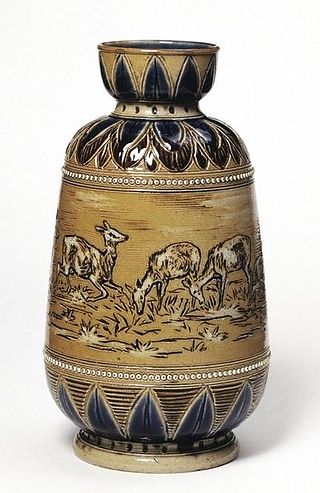
Clarice Cliff was an English ceramic artist and designer. Active from 1922 to 1963, Cliff became the head of the factory creative department.

Susan Vera Cooper OBE was a prolific English ceramic designer working in the Stoke-on-Trent pottery industries from the 1920s to the 1980s.

The Etruria Works was a ceramics factory opened by Josiah Wedgwood in 1769 in a district of Stoke-on-Trent, Staffordshire, England, which he named Etruria. The factory ran for 180 years, as part of the wider Wedgwood business.

Staffordshire University is a public research university in Staffordshire, England. It has one main campus based in the city of Stoke-on-Trent and four other campuses; in Stafford, Lichfield, Shrewsbury and London.

Burslem is one of the six towns that along with Hanley, Tunstall, Fenton, Longton and Stoke-upon-Trent form part of the city of Stoke-on-Trent in Staffordshire, England. It is often referred to as the "mother town" of Stoke on Trent.
Arthur Berry was an English playwright, poet, teacher and artist, who was born in Smallthorne, Stoke-on-Trent. His individual creative work became deeply rooted in the culture, people and landscape of the industrial pottery town of Burslem.

Tunstall is one of the six towns that, along with Burslem, Longton, Fenton, Hanley and Stoke-upon-Trent, amalgamated to form the City of Stoke-on-Trent in Staffordshire, England. It was one of the original six towns that federated to form the city. Tunstall is the most northern, and fourth largest town of the Potteries. It is situated in the very northwest of the city borough, with its north and west boundaries being the city limit. It stands on a ridge of land between Fowlea Brook to the west and Scotia Brook to the east, surrounded by old tile-making and brick-making sites, some of which date back to the Middle Ages.

Charlotte Rhead was an English ceramics designer active in the 1920s and the 1930s in the Potteries area of Staffordshire.

Royal Doulton is an English ceramic and home accessories manufacturer that was founded in 1815. Operating originally in Vauxhall, London, and later moving to Lambeth, in 1882 it opened a factory in Burslem, Stoke-on-Trent, in the centre of English pottery. From the start, the backbone of the business was a wide range of utilitarian wares, mostly stonewares, including storage jars, tankards and the like, and later extending to drain pipes, lavatories, water filters, electrical porcelain and other technical ceramics. From 1853 to 1901, its wares were marked Doulton & Co., then from 1901, when a royal warrant was given, Royal Doulton.
The Stoke-on-Trent Regional College of Art was one of three colleges that were merged in 1971 to form North Staffordshire Polytechnic. The College of Art achieved Regional Art College status after the Second World War, but its roots lay in the nineteenth century as it was formed from three of the Potteries´ art schools.

Pilkington's Lancastrian Pottery & Tiles was a manufacturer of tiles, vases and bowls, based in Clifton near Pendlebury, Lancashire, England. The company was established in 1892 at Clifton Junction, alongside Fletcher's Canal. The company employed talented designers, the most famous of whom was Charles Voysey. Production of art pottery was stopped at the end of the 1930s, although tile production continued. Today the site is occupied by Pilkington's Group Plc.
Dorothy Jessie Tait was a prolific English ceramic designer working in the Stoke-on-Trent pottery industries, most prominently for Midwinter, from the 1940s to the 1980s.

The Wedgwood Institute is a large red-brick building that stands in Queen Street, in the town of Burslem, Stoke-on-Trent, Staffordshire, England. It is sometimes called the Wedgwood Memorial Institute, but it is not to be confused with the former Wedgwood Memorial College in Barlaston. It achieved listed building status in 1972.
Gordon Mitchell Forsyth (1879–1952) was a Scottish ceramic designer and fine artist and art education innovator.
Reginald George Haggar (1905–1988) R.I., A.R.C.A., F.R.S.A. was a British ceramic designer. He was born in Ipswich and studied at Ipswich School of Art and the Royal College of Art. In 1929, he became assistant designer at Mintons pottery in Stoke-on-Trent, rising to art director six months later, a post he held until 1939. Working in water colours and ceramics, his designs reflected both the radical and lyrical elements of the Art Deco style.
John Shelton was an English painter and ceramic artist born in Shelton, Stoke-on-Trent.

Moira Forsyth was an English stained-glass artist. Her father was Gordon Forsyth a Scottish ceramics designer, stained-glass artist, and teacher. They both made works for the St. Joseph's Church in Burslem, Stoke-on-Trent, Staffordshire. She made her name for her stained-glass works, such as those found at Guildford Cathedral, Norwich Cathedral and Eton College Chapel.
Gray's Pottery, also spelled as Grays Pottery and formally known as A.E. Gray Ltd. was a British pottery company based in Hanley, Staffordshire, later Stoke-upon-Trent, which existed until it was taken over by Portmeirion Pottery in 1960.

Millicent (Millie) Jane Taplin (1902–1980) was a British designer and painter of ceramics who spent most of her career at Josiah Wedgwood and Sons (1917–1962). She was trained in painting by Alfred and Louise Powell, and supervised Wedgwood's ceramics painters. She became a designer of decorative patterns in 1929 and by the mid-to-late 1930s was one of the company's main designers, although she did not design pottery shapes. She was one of only two working-class women to become a successful ceramics designer before the Second World War. Her tableware designs were exhibited by Wedgwood at Grafton Galleries in London in 1936, and several of her designs are now on display at the V&A Museum. Her design "Strawberry Hill", with Victor Skellern, was awarded the Council of Industrial Design's Design of the Year Award in 1957.
Victor G. Skellern (1909–1966) was a British ceramics designer and stained glass producer who was the art director at Wedgwood from 1934 to 1965. He helped to modernise Wedgwood, and his design work was a factor in the company's resurgence after 1935. He was also known for employing well-known designers from outside the company. Skellern's ceramics designs were exhibited at Grafton Galleries (1936) and the Britain Can Make It exhibition (1946) in London. Some of his designs are now on display at the V&A Museum, Yale Center for British Art, Museum of Applied Arts & Sciences and the Wedgwood Museum. His design "Strawberry Hill", with Millicent Taplin, was awarded the Council of Industrial Design's Design of the Year Award in 1957.












